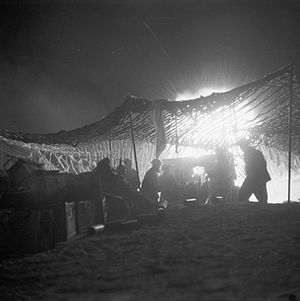Operation Pugilist
| Battle of the Mareth Line | |||||||
|---|---|---|---|---|---|---|---|
| Part of the Tunisia Campaign of the Second World War | |||||||
 A British 25-pounder field gun in action at night, during the assault on the Mareth Line |
|||||||
|
|||||||
| Belligerents | |||||||
|
|
|
||||||
| Commanders and leaders | |||||||
|
|
|
||||||
| Casualties and losses | |||||||
| 4,000 casualties | not available 7,000 captured |
||||||
| Jebel Dahar | |
|---|---|
The Battle of the Mareth Line or the Battle of Mareth was an attack in the Second World War by the British Eighth Army (General Bernard Montgomery) in Tunisia, against the Mareth Line held by the Italo-German 1st Army (General Giovanni Messe). It was the first big operation by the Eighth Army since the Second Battle of El Alamein 4 1⁄2 months previously. Operation Pugilist, the first British attack, established a bridgehead but a break-out attempt was defeated by Axis counter-attacks. Pugilist established an alternative route of attack and Operation Supercharge II, an outflanking manoeuvre via the Tebaga Gap was planned. Montgomery reinforced the flanking attack, which from 26–31 March, forced the Axis 1st Army to retreat to Wadi Akarit, another 40 mi (64 km) back in Tunisia.
The retreat of Panzer Army Africa (known as the Deutsch-Italienische Panzerarmee/Armata Corazzata Italo-Tedesca from October 1942) took place from 5 November 1942 – 15 February 1943. On 8 November, Operation Torch began in Morocco, Algeria and Tunisia, as Panzeramee Afrika in Egypt managed to evade British outflanking moves but traffic jams, fuel shortages, poor weather and air attacks reduced the speed of the retreat to 6–7 mi (9.7–11.3 km) per day. Comando Supremo in Rome and OKW in Berlin took an optimistic view of the situation and Comando Supremo chose the Mersa-el-Brega–El Agheila position as the terminus of the retreat, despite the position having a front of 110 mi (180 km), strong points up to 5 mi (8.0 km) apart, which was too far for mutual support and only 30,000 mines. When the Panzerarmee arrived, the Afrika Korps had only 5,000 men, 35 tanks, 16 armoured cars, 12 anti-tank guns, 12 field howitzers and deliveries of only 50 long tons (51 t) of the 400 long tons (410 t) of supplies needed daily.
...
Wikipedia

